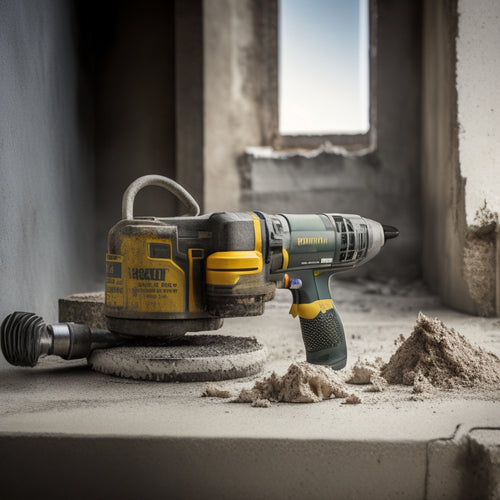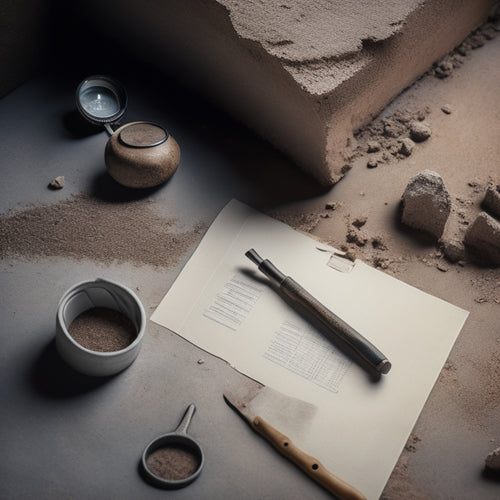
10 Free Templates to Simplify Home Renovation Planning
Share
You're about to plunge into a home renovation project and want to simplify the planning process. You're in luck! We've got 10 free templates to help you stay organized and on track. From a bathroom remodeling project timeline to a kitchen design and budget tracker, these templates will walk you through every stage of your renovation. Measure your rooms with precision using a room measurement and layout template, and calculate material quantities with ease. Track your expenses, permits, and progress with our templates, and even create a mood board to visualize your dream space. With these templates, you'll be well on your way to a stress-free renovation - and that's just the beginning.
Key Takeaways
- Utilize a project management template to establish a timeline, track progress, and avoid delays in your home renovation project.
- Create a detailed budget breakdown to allocate funds, prioritize spending, and track expenses throughout the renovation process.
- Design and layout planning templates help visualize your space, optimize furniture arrangement, and ensure accurate measurements.
- Develop a communication plan and contingency strategy to mitigate potential issues and ensure seamless collaboration with contractors.
- Leverage templates for permit and inspection checklists to ensure compliance with regulations and avoid costly rework.
Bathroom Remodeling Project Timeline
When diving into a bathroom remodeling project, you're likely enthusiastic to get started, but taking the time to create a detailed timeline is crucial to staying on track and avoiding costly delays. A well-planned timeline outlines key milestones, renovation phases, and task dependencies, guaranteeing a smooth project flow.
Begin by identifying design considerations, such as layout changes, fixture replacements, and finish selections. Next, establish a communication plan with your contractor to guarantee seamless collaboration.
Material selection and budgeting strategies should also be prioritized, as they greatly impact the project's overall cost and timeline. As you finalize your timeline, identify areas for potential adjustments and develop contingency plans to mitigate delays.
Kitchen Design and Budget Tracker
You'll need to evaluate various kitchen layout options to maximize your space, from L-shapes and U-shapes to galley kitchens and open concepts.
As you explore these designs, it's crucial to keep track of your expenses, which is where a budget breakdown comes in, outlining must-haves like cabinetry, countertops, and appliances.
Kitchen Layout Options
As you begin planning your kitchen renovation, one of the most critical decisions you'll make is the layout of your kitchen. This will impact your workflow, storage, and overall aesthetic.
Consider an open concept layout, which eliminates barriers between the kitchen and living areas, creating a seamless flow. Alternatively, a galley style layout can provide an efficient workflow, with appliances and countertops lined up in a linear fashion.
For a more traditional look, an L-shaped design or U-shaped layout can provide ample counter space and storage solutions. If you have the room, an island configuration can increase counter space and create a social hub.
For a rustic touch, consider a farmhouse kitchen with its characteristic exposed beams and natural materials. Whatever your style, prioritize modern aesthetics and efficient workflow.
Optimize your space with clever storage solutions, such as pull-out pantries and hidden trash cans. By choosing the right layout, you'll create a kitchen that's both beautiful and functional.
Budget Breakdown Essentials
Creating a detailed budget breakdown is essential to ensuring your kitchen renovation stays on track financially.
You'll need to allocate funds for materials, labor, and unexpected expenses. A well-planned budget breakdown helps you prioritize spending, make informed decisions, and avoid costly surprises.
When developing your budget allocation strategies, consider the following essential components:
-
Materials and fixtures: Calculate the cost of cabinets, countertops, appliances, and other necessary items.
-
Labor costs: Determine the cost of hiring professionals, such as contractors, electricians, and plumbers.
-
Permits and inspections: Factor in the cost of obtaining necessary permits and undergoing inspections.
- Contingency fund: Set aside a portion of your budget for unexpected expenses, such as discovering hidden structural damage.
Room Measurement and Layout Template
Measuring your room accurately is essential to achieving a successful home renovation. It's vital to get it right to avoid costly mistakes and guarantee your new space fits your needs.
With our Room Measurement and Layout Template, you'll be able to capture precise dimensions and map out your room's layout.
When taking measurements, remember to:
| Measurement Tips | Why It Matters |
| Measure to the center of doors and windows | Guarantee accurate placement of furniture and fixtures |
| Record measurements in multiple units (e.g., feet, inches, centimeters) | Easily convert between units and guarantee accuracy |
| Measure door and window swing directions | Plan for proper clearance and flow |
| Take photos of each wall and corner | Visualize your space and identify potential issues |
Material Quantity Calculator Spreadsheet
You'll need a clear picture of the materials required for your renovation project, and that's where a Material Quantity Calculator Spreadsheet comes in.
This template helps you calculate material needs accurately, ensuring you have everything you need on hand.
Calculate Material Needs
Accurate material calculations are essential to avoiding costly mistakes and guaranteeing your home renovation project stays on track. You can't afford to underestimate or overestimate the materials needed, as this can lead to delays, budget overruns, and unnecessary stress.
With a Material Quantity Calculator Spreadsheet, you can calculate material needs with precision, guaranteeing you have exactly what you need when you need it.
To get the most out of your calculator, follow these best practices:
-
Measure twice, calculate once: Double-check your measurements to avoid errors that can throw off your calculations.
-
Account for waste and irregularities: Factor in waste material and irregularities in your calculations to guarantee you have enough material on hand.
-
Research material sourcing strategies: Explore different suppliers and material options to find the best deals and optimize your budget.
- Refine your cost estimation techniques: Use historical data and industry benchmarks to refine your cost estimation techniques and guarantee accuracy.
Track Quantities Easily
With your Material Quantity Calculator Spreadsheet up and running, you're now poised to track quantities with ease. This powerful tool enables you to efficiently manage your inventory, ensuring that you have the right materials in the right quantities at the right time. By accurately tracking your materials, you can streamline your material sourcing, improve supplier communication, and optimize your project's efficiency.
| Material | Quantity Needed | Quantity On Hand |
|---|---|---|
| Lumber | 1000 ft | 800 ft |
| Drywall | 500 sheets | 300 sheets |
| Paint | 20 gallons | 15 gallons |
With this spreadsheet, you can easily identify potential shortages or overages, allowing you to make adjustments to your supply chain and labor allocation. This not only helps reduce waste and costs but also enables you to allocate your resources more effectively. By leveraging this powerful tool, you can take your renovation logistics to the next level, ensuring that your project stays on track and within budget.
Avoid Costly Errors
By keeping a close eye on your material quantities, you're well-equipped to tackle the next challenge: avoiding costly errors. A misestimated material quantity can lead to project delays, budget overruns, and even conflicts with contractors.
To prevent these pitfalls, use our Material Quantity Calculator Spreadsheet to accurately calculate your material needs.
Here are some common areas where errors can occur:
-
Cost estimation: Miscalculating material costs can lead to budget overruns. Verify you account for all materials, including small items like screws and adhesives.
-
Design planning: Inaccurate design plans can result in material waste or insufficient quantities. Double-check your design plans to avoid costly mistakes.
-
Material sourcing: Incorrect material sourcing can lead to delays or even project cancellation. Confirm the availability of materials before finalizing your plans.
- Project prioritization: Poor project prioritization can lead to inefficient use of resources, causing delays and cost overruns. Prioritize tasks based on material availability and urgency.
Renovation Budget Breakdown Worksheet
You've allocated a budget for your home renovation, but now it's vital to break it down into specific categories to confirm you're assigning sufficient funds to each aspect of the project. A renovation budget breakdown worksheet is a valuable tool for this process, enabling you to itemize and track expenses.
By categorizing your renovation cost into areas like materials, labor, and permits, you can identify potential budget tips and areas for savings strategies. This worksheet also allows you to explore funding options, considering investment returns and potential budget adjustments.
Expense tracking becomes more manageable, and you can conduct a thorough cost analysis to verify your financial planning is on track. With a clear project financing plan in place, you can make informed decisions about where to allocate your funds, maximizing your investment returns and minimizing the risk of costly errors.
DIY Project Task List and Schedule
You'll need to create a task breakdown, identifying each step required to complete your DIY project.
Next, you'll organize these tasks into a project timeline view, visualizing how each task fits into the overall project schedule.
Task Breakdown Steps
Divide your DIY project into manageable chunks by identifying the tasks required to complete each stage. This is essential in creating an efficient workflow and avoiding overwhelming situations.
By breaking down your project into smaller tasks, you can focus on one task at a time, making it easier to manage your time and resources.
To create a thorough task breakdown, follow these steps:
-
Define project stages: Identify the major stages of your project, such as demolition, installation, and finishing.
-
Identify tasks per stage: Break down each stage into smaller tasks, such as removing flooring, installing cabinets, or painting walls.
-
Determine task dependencies: Identify which tasks are dependent on others, ensuring you complete tasks in the correct order.
- Assign task priorities: Use task prioritization strategies to determine which tasks to complete first, ensuring you're focusing on the most important tasks.
Project Timeline View
A well-structured project timeline view is essential for visualizing your DIY project's progression and staying on track. This template allows you to outline your project milestones and renovation phases, giving you a clear picture of what needs to be done and when.
By breaking down your project into manageable chunks, you can identify dependencies, critical paths, and potential roadblocks. With a project timeline view, you can allocate resources, assign tasks, and set realistic deadlines. This will help you stay focused, prioritize tasks, and make adjustments as necessary.
In this template, you'll be able to list your project milestones, such as "Demolition Complete" or "Inspections Passed," and connect them to specific renovation phases, like "Framing" or "Electrical Installation."
You can also include key dates, such as permits issued or materials delivery, to guarantee a smooth workflow. By having a clear project timeline view, you'll be able to track your progress, identify potential delays, and make informed decisions to keep your project on schedule and within budget.
Daily Work Schedule
As you map out your project's timeline, you'll also need to focus on the day-to-day tasks that will bring your vision to life.
A daily work schedule is essential for managing the renovation process and ensuring that your project stays on track. With a clear plan, you'll be able to allocate tasks, set deadlines, and track progress.
To create an effective daily work schedule, consider the following:
-
Break down large tasks into smaller ones: Divide complex tasks into smaller, manageable chunks to avoid feeling overwhelmed.
-
Assign tasks to specific days: Allocate specific tasks to specific days to maintain a sense of structure and routine.
-
Set realistic deadlines: Be realistic about what can be accomplished in a day, and set deadlines accordingly to avoid burnout.
- Leave room for flexibility: Allow for unexpected setbacks or changes by building in some flexibility to your daily schedule.
Home Decor Style Mood Board Template
Crafting your dream home's aesthetic begins with a clear vision, and that's where a home decor style mood board template comes into play. This powerful tool helps you distill your design aspirations into a cohesive visual representation, making it easier to communicate your ideas to contractors, designers, or anyone else involved in your renovation project.
With a mood board, you'll be able to curate mood board inspiration from various sources, such as Pinterest, magazines, or even nature, and combine them into a single, unified concept.
Using a home decor style mood board template, you'll be able to experiment with different color palette ideas, textures, and patterns, ensuring that your design elements work harmoniously together. You can add images of furniture, fixtures, and materials that resonate with your style, creating a visual roadmap for your renovation.
This template will help you stay focused on your design goals, saving you time and energy in the long run. By having a clear visual representation of your design vision, you'll be able to make more informed decisions and bring your dream home to life.
Floor Plan and Furniture Layout Tool
You've nailed down your design vision with a home decor style mood board, now it's time to think about the physical space. A floor plan and furniture layout tool is essential for visualizing your space and guaranteeing a seamless renovation.
This tool allows you to create a 2D or 3D representation of your floor plan, including room dimensions, doorways, and windows.
With a floor plan and furniture layout tool, you can:
- Optimize furniture arrangement to maximize space and comfort.
- Visualize traffic flow to avoid bottlenecks and guarantee a smooth shift between rooms.
- Balance design aesthetics with layout functionality to create a harmonious space.
- Integrate style with comfort considerations to guarantee your space is both beautiful and functional.
Permit and Inspection Checklist Template
Securing the necessary permits and passing inspections are essential steps in a successful home renovation. To make certain you're on top of these important tasks, use a Permit and Inspection Checklist Template. This tool helps you navigate the often-complex permit application process, assuring compliance with local ordinances and building codes.
With a thorough compliance checklist, you'll never miss an inspection requirement or renovation regulation. You'll be able to track the approval process, from initial submission to final project permits. The template also streamlines inspection scheduling, including safety inspections, so you can plan accordingly.
By breaking down the permit and inspection process into manageable tasks, you'll save time and reduce stress. Stay organized, and avoid costly delays or fines due to non-compliance.
With this template, you'll be confident that your renovation meets all necessary standards, giving you peace of mind and a successful project outcome.
Project Progress and Expense Tracker
As your home renovation project unfolds, staying on top of progress and expenses becomes essential to its success. You need a clear renovation strategy to guarantee your project stays on track and within budget.
A project progress and expense tracker is a valuable tool to help you achieve this.
With this template, you'll be able to:
-
Record progress updates: Keep a log of completed tasks, ongoing work, and upcoming milestones to stay informed about your project's status.
-
Track expenses: Monitor your spending on materials, labor, and permits to guarantee you're staying within your budget.
-
Identify areas for improvement: Analyze your progress and expenses to pinpoint areas where you can optimize your renovation strategy.
- Maintain accurate expense documentation: Keep a detailed record of your expenses for tax purposes, insurance claims, or future reference.
Frequently Asked Questions
How Do I Ensure My Renovation Stays Within Budget?
To guarantee your renovation stays within budget, you'll want to master budgeting strategies like prioritizing must-haves, allocating contingencies, and identifying cost-cutting tips, such as repurposing materials, DIY projects, and negotiating with contractors.
Can I Reuse Old Materials in My New Design?
You're a master chef, remixing old ingredients into a new culinary masterpiece. Yes, you can reuse old materials in your new design, embracing sustainable design and creative upcycling to reduce waste and inject character into your renovated space.
Do I Need a Permit for Cosmetic Changes?
You'll likely need permits for structural changes, but cosmetic updates like painting or swapping fixtures typically don't require them; however, it's crucial to check with local authorities to determine which permit types apply to your specific project.
How Long Does a Typical Home Renovation Project Take?
You'll want to understand that a typical home renovation project's timeline depends on various factors, including project phases, which can be broken down into design, permitting, construction, and inspection, with each phase influencing the overall duration of your renovation journey.
Can I Do Renovation Work Without Hiring a Professional?
You're a superhero, capable of tackling anything, but DIY renovation work without a pro? Think twice! Conduct a thorough risk assessment, gather DIY tips, and weigh the consequences before deciding to go solo – it's not worth risking your sanity or safety.
Conclusion
You've got this! With these 10 free templates, you'll be well on your way to a stress-free home renovation. Don't think you're not organized enough to tackle a project of this scope - that's exactly what these templates are for. They'll help you stay on top of every detail, ensuring your dream renovation becomes a reality. By using them, you'll save time, money, and your sanity. So, what are you waiting for? Get started today and watch your renovation plans fall into place!
Related Posts
-

Top Drill for Concrete Wall Renovation
When choosing the top drill for your concrete wall renovation, you'll want to prioritize key features like drill powe...
-

Crack Repair Inspection Checklist for Home Renovation
When creating a crack repair inspection checklist for your home renovation project, you'll want to identify crack typ...
-

Why Inspect Stucco Repair Equipment Before Renovation
When starting a stucco repair renovation, you need to inspect your equipment to prevent accidents, save time and mone...


